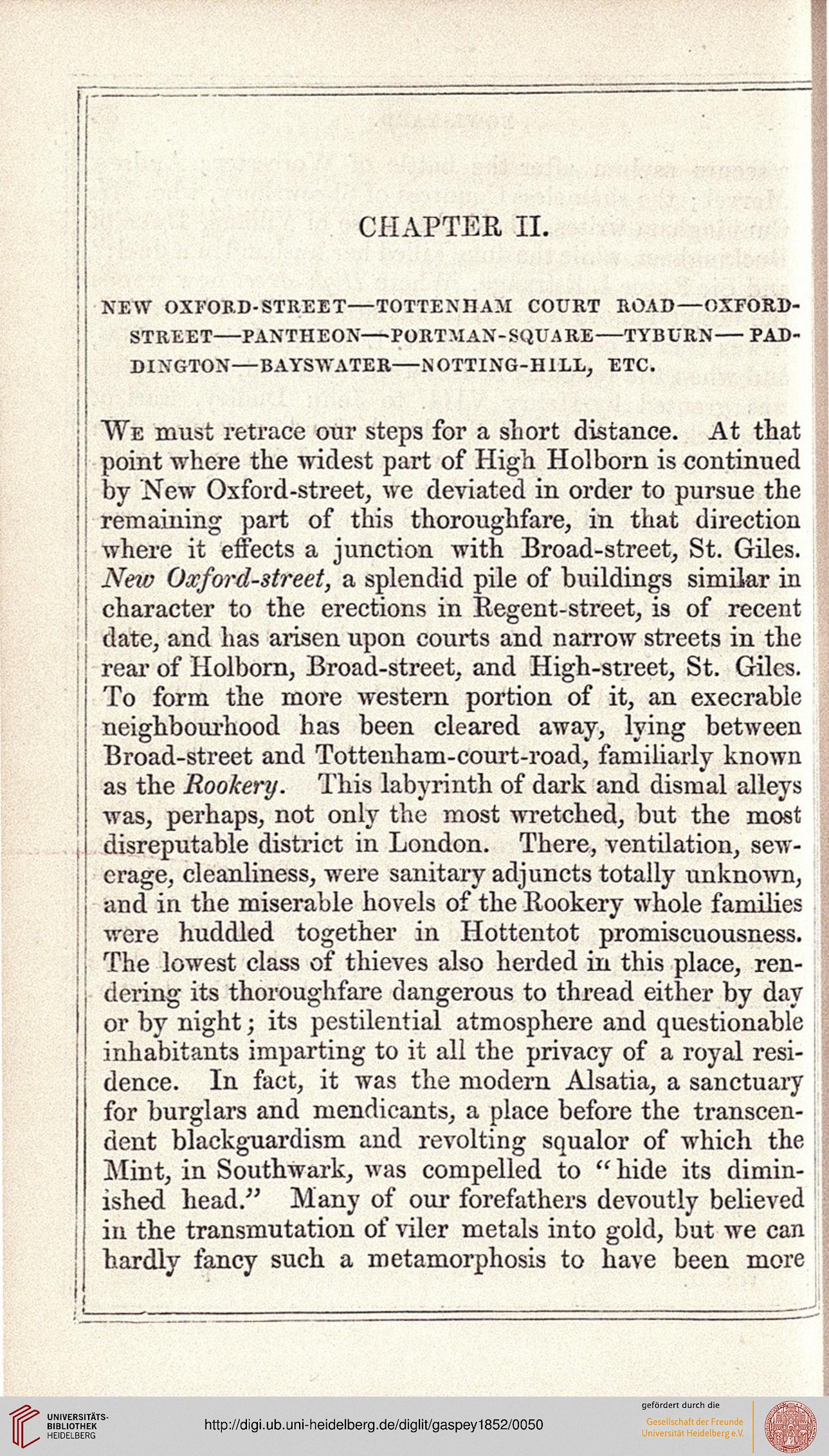CHAPTER II.
NEW OXFORD-STREET—TOTTENHAM COURT ROAD—OXFORD-
STREET—PANTHEON—PORTMAN- SQUARE—TYBURN----PAJ>-
DINGTON—BAYSWATER—NOTTING-HlLL, ETC.
We must retrace our steps for a short distance. At that
point where the widest part of High Holborn is continued
by New Oxford-street, we deviated in order to pursue the
remaining part of this thoroughfare, in that direction
where it effects a junction with Broad-street, St. Giles.
New Oxford-street, a splendid pile of buildings similar in
character to the erections in Regent-street, is of recent
date, and has arisen upon courts and narrow streets in the
real* of Holborn, Broad-street, and High-street, St. Giles.
To form the more western portion of it, an execrable
neighbourhood has been cleared away, lying between
Broad-street and Tottenham-court-road, familiarly known
as the Rookery. This labyrinth of dark and dismal alleys
was, perhapSj not only the most wretched, but the most
disreputable district in London. There, ventilation, sew-
erage, cleanliness, were sanitary adjuncts totally unknown,
and in the miserable hovels of the Rookery whole families
were huddled together in Hottentot promiscuousness.
The lowest class of thieves also herded in this place, ren-
dering its thoroughfare dangerous to thread either by day
or by night; its pestilential atmosphere and questionable
inhabitants imparting to it all the privacy of a royal resi-
dence. In fact, it was the modern Alsatia, a sanctuary
for burglars and mendicants, a place before the transcen-
dent blackguardism and revolting squalor of which the
Mint, in Southwark, was compelled to " hide its dimin-
ished, head." Many of our forefathers devoutly believed
in the transmutation of viler metals into gold, but we can
hardly fancy such a metamorphosis to have been more
NEW OXFORD-STREET—TOTTENHAM COURT ROAD—OXFORD-
STREET—PANTHEON—PORTMAN- SQUARE—TYBURN----PAJ>-
DINGTON—BAYSWATER—NOTTING-HlLL, ETC.
We must retrace our steps for a short distance. At that
point where the widest part of High Holborn is continued
by New Oxford-street, we deviated in order to pursue the
remaining part of this thoroughfare, in that direction
where it effects a junction with Broad-street, St. Giles.
New Oxford-street, a splendid pile of buildings similar in
character to the erections in Regent-street, is of recent
date, and has arisen upon courts and narrow streets in the
real* of Holborn, Broad-street, and High-street, St. Giles.
To form the more western portion of it, an execrable
neighbourhood has been cleared away, lying between
Broad-street and Tottenham-court-road, familiarly known
as the Rookery. This labyrinth of dark and dismal alleys
was, perhapSj not only the most wretched, but the most
disreputable district in London. There, ventilation, sew-
erage, cleanliness, were sanitary adjuncts totally unknown,
and in the miserable hovels of the Rookery whole families
were huddled together in Hottentot promiscuousness.
The lowest class of thieves also herded in this place, ren-
dering its thoroughfare dangerous to thread either by day
or by night; its pestilential atmosphere and questionable
inhabitants imparting to it all the privacy of a royal resi-
dence. In fact, it was the modern Alsatia, a sanctuary
for burglars and mendicants, a place before the transcen-
dent blackguardism and revolting squalor of which the
Mint, in Southwark, was compelled to " hide its dimin-
ished, head." Many of our forefathers devoutly believed
in the transmutation of viler metals into gold, but we can
hardly fancy such a metamorphosis to have been more




